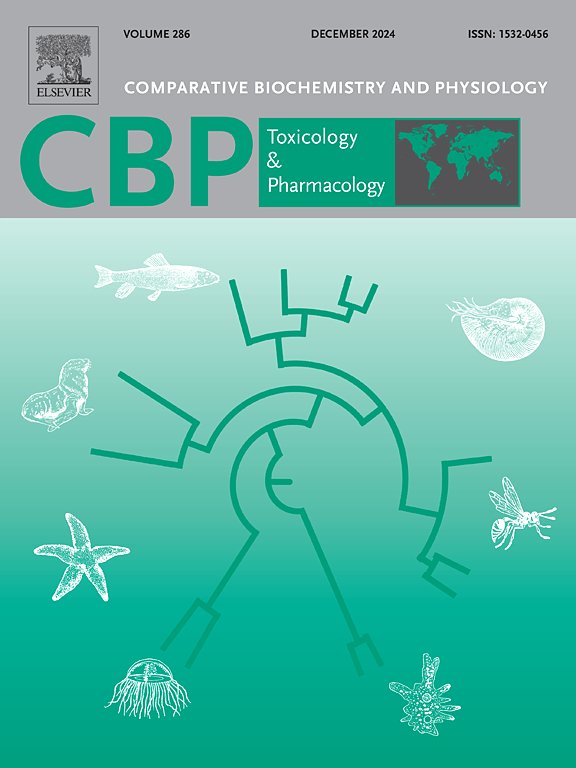A genus-wide study on venom proteome variation and phospholipase A2 inhibition in Asian lance-headed pit vipers (genus: Trimeresurus)
IF 3.9
3区 环境科学与生态学
Q2 BIOCHEMISTRY & MOLECULAR BIOLOGY
Comparative Biochemistry and Physiology C-toxicology & Pharmacology
Pub Date : 2025-02-01
DOI:10.1016/j.cbpc.2024.110077
引用次数: 0
Abstract
High molecular weight proteins are present abundantly in viperid venoms. The amino acid sequence can be highly variable, contributing to the structure and function diversity of snake venom protein. However, this variability remains poorly understood in many species. The study investigated the venom protein variability in a distinct clade of Asian pit vipers (Trimeresurus species complex) through comparative proteomics, applying gel electrophoresis (SDS-PAGE), liquid chromatography-tandem mass spectrometry (LCMS/MS), and bioinformatic approaches. The proteomes revealed a number of conserved protein families, within each are variably expressed protein paralogs that are unrelated to the snake phylogeny and geographic origin. The expression levels of two major enzymes, i.e., snake venom serine proteinase and metalloproteinase, correlate weakly with procoagulant and hemorrhagic activities, implying co-expression of other functionally versatile toxins in the venom. The phospholipase A2 (PLA2) abundance correlates strongly with its enzymatic activity, and a unique phenotype was discovered in two species expressing extremely little PLA2. The commercial mono-specific antivenom effectively neutralized the venoms' procoagulant and hemorrhagic effects but failed to inhibit the PLA2 activities. Instead, the PLA2 activities of all venoms were effectively inhibited by the small molecule inhibitor varespladib, suggesting its potential to be repurposed as a highly potent adjuvant therapeutic in snakebite envenoming.

关于亚洲矛头蝮蛇(属:Trimeresurus)毒液蛋白质组变异和磷脂酶 A2 抑制作用的全属研究。
毒蛇毒液中含有大量高分子量蛋白质。不过,其氨基酸序列可能会有很大差异,从而导致蛇毒蛋白质的结构和功能多样性。然而,这一点在许多物种中仍未得到解决。这项研究采用凝胶电泳(SDS-PAGE)、液相色谱-串联质谱(LCMS/MS)和生物信息学方法,通过比较蛋白质组学研究了亚洲蝮蛇(Trimeresurus species)一个独特支系的毒液蛋白变异性。蛋白质组发现了许多保守的蛋白质家族,每个家族中都有表达量不同的蛋白质旁系亲属,这些旁系亲属与蛇的系统发育和地理起源无关。两种主要酶(即蛇毒丝氨酸蛋白酶和金属蛋白酶)的表达水平与促凝血和出血活性关系不大,这意味着蛇毒中还存在其他功能多样的毒素。磷脂酶 A2(PLA2)的丰度与其酶活性密切相关,在两个表达极少 PLA2 的物种中发现了一种独特的表型。商用单特异性抗蛇毒血清有效地中和了毒液的促凝血和出血作用,但未能抑制 PLA2 活性。相反,小分子抑制剂 varespladib 能有效抑制所有毒液的 PLA2 活性,这表明它有可能被重新用作蛇咬伤毒液的强效辅助疗法。
本文章由计算机程序翻译,如有差异,请以英文原文为准。
求助全文
约1分钟内获得全文
求助全文
来源期刊
CiteScore
7.50
自引率
5.10%
发文量
206
审稿时长
30 days
期刊介绍:
Part C: Toxicology and Pharmacology. This journal is concerned with chemical and drug action at different levels of organization, biotransformation of xenobiotics, mechanisms of toxicity, including reactive oxygen species and carcinogenesis, endocrine disruptors, natural products chemistry, and signal transduction with a molecular approach to these fields.

 求助内容:
求助内容: 应助结果提醒方式:
应助结果提醒方式:


